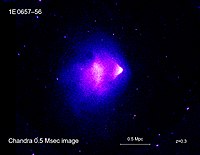
Photo from wikipedia
We describe a general purpose method to reconstruct the intrinsic properties of sources lensed by the gravitational potential of foreground clusters of galaxies. The tool Lenstruction is implemented in the… Click to show full abstract
We describe a general purpose method to reconstruct the intrinsic properties of sources lensed by the gravitational potential of foreground clusters of galaxies. The tool Lenstruction is implemented in the publicly available multi-purpose gravitational lensing software Lenstronomy, in order to provide easy and fast solution to this common astrophysical problem. The tool is based on forward modeling the appearance of the source in the image plane, taking into account the distortion by lensing and the instrumental point spread function (PSF). For singly-imaged sources a global lens model in the format of the Hubble Frontier Fields (HFF) lensing maps is required as a starting point. For multiply-imaged sources, the tool can also fit and apply first (deflection) second (shear, convergence) and third order (flexion) corrections to the local gravitational potential to improve the overall reconstruction, depending on the quality of the data. We illustrate the performance and features of the code with two examples of multiply-imaged systems taken from the Hubble Frontier Fields, starting from five different publicly available cluster models. We find that, after our correction, the relative magnification - and other lensing properties - between the multiple images become robustly constrained. Furthermore, we find that scatter between models of the reconstructed source size and magnitude is reduced. The code and jupyter notebooks are publicly available.
Journal Title: Monthly Notices of the Royal Astronomical Society
Year Published: 2020
Link to full text (if available)
Share on Social Media: Sign Up to like & get
recommendations!